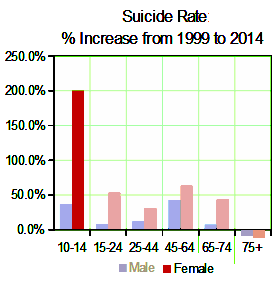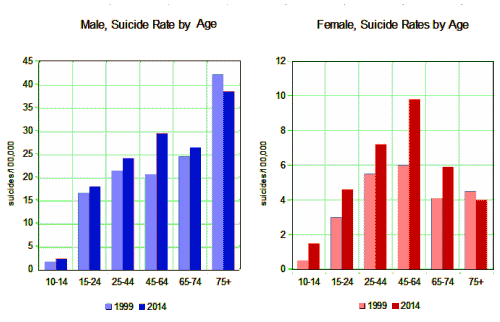 When I read population statistics like the suicide figures in the last post [what’s missing…], I don’t exactly know what to do with them, what to take away that might help in my own work. Ned Shorter points us to one thing – the dramatic increases in suicides in teenaged girls [Teen Suicide: Parents Guard Your Daughters], likening it to the well known historical waves of peer suggestability in this demographic. I would only add that it elevates the newer teen identity "emo" to something bigger and more ominous than a fad. It’s an area often discounted as attention seeking, but it apparently needs more of our attention.
When I read population statistics like the suicide figures in the last post [what’s missing…], I don’t exactly know what to do with them, what to take away that might help in my own work. Ned Shorter points us to one thing – the dramatic increases in suicides in teenaged girls [Teen Suicide: Parents Guard Your Daughters], likening it to the well known historical waves of peer suggestability in this demographic. I would only add that it elevates the newer teen identity "emo" to something bigger and more ominous than a fad. It’s an area often discounted as attention seeking, but it apparently needs more of our attention.
My own take was that the overall increased suicide rates says something about our mental health system, or perhaps I should say the dysfunctional state of our mental health system. I would think that independent of any of the other factors that may or may not be operative. We haven’t risen to the challenge. How many articles have you read lately about emergency psychiatric services? or systems? or programs? or suicidality? – not just in Psychiatric journals? but in Psychology? or Social Work? And whatever the term Managed Care means, those forces have jumped on the concept of Evidence Based Medicine and used it to restrict or deny services that are actually vital to any functional mental health system, public or private. In many [most?] cases, suicidality is subjective, deeply rooted in the unique circumstances and narrative of the individual. As such, the only valid control would be the individual him·or·her·self. Likewise, the only thing the mental health system can do about suicide rates has to do with the patients it actually sees and engages. So we can make services easily accessed and effective. And to be effective they must include what we know, not just what we can prove with objective Evidence Based Medicine. And we’re just not doing any of it.
Washington PostBy Lena H. Sun and Amy Ellis NuttOctober 8, 2015
What could you have done differently to change that trajectory?
Insel: We need better science. Just as we need that in cancer and heart disease and diabetes, we need to do that for mental illness. So we have to keep raising the bar, investing in science, getting the very best science done. When I first came into the job in 2002, one of the very first talks I gave I talked about the excitement of the science, and at that point, I was talking mostly about epigenetics [the study of how environments affect genes], which was just becoming a reality. And it seemed to me to be transformative and so exciting. It was such an innovation. And [then] someone in the audience said, “Excuse me, but our house is on fire, and you’re talking to me about the chemistry of the paint.” I never forgot that. And I think we have to be very honest with ourselves. That indeed the chemistry of the paint is important and very interesting and it will probably make sure it’s a better and safer house in 10 to 20 years. But we have to do something with the house that’s on fire as well. I worry that we didn’t do well enough on that score.What would you have liked to have done at NIMH that you were not able to do?
Insel: When I look at what I would say is my biggest failure, it’s that I don’t think that the investment we made with the money that we were given had an impact on the suicide rate, on the morbidity of any major mental illness. There are lots of explanations for why the rapid progress in science didn’t translate to much better outcomes for people with serious mental illness. I hear all that, but what keeps me up at night is knowing that the suicide rate is now higher than the mortality rate from breast cancer — I just find that extraordinary. That there are almost three times the number of suicides as homicides in this country — the homicide rate has come down by 50 percent and the suicide rate is trending up. That is, to me, unacceptable…
Tom Insel wears a monocle that always sees the same thing – a future age of understanding of the neurobiological core of mental illness revealed through a series of new technologies responsive to biological interventions, and has relentlessly driven the NIMH towards that goal. He’s even spearheading the development of a new classification of mental phenomena based on the findings from these technologies – Research Domain Criteria [RDoC]. In a January blog post, he wrote of challenges to his monocular view:
Balancing Immediate Needs with Future Innovation
NIMH Director’s Blog
By Thomas Insel
January 26, 2012NIMH, like all Institutes at NIH, has an advisory council that meets three times each year. The National Advisory Mental Health Council (NAMHC) is a distinguished group of scientists, advocates, clinicians, and policy experts. Each of our meetings includes a closed session to review individual grants considered for funding and a session open to the public that engages this diverse group in discussions about the larger issues that guide NIMH funding.
At last week’s session, we heard a recurrent tension around one such larger issue. Some members of Council bear witness to the poor quality of care, the unmet medical need, and the diminishing investments by states on behalf of people with mental disorders. They reasonably ask, “How are we ensuring that the science that NIMH has produced is implemented where the need is greatest?” They also question on the pay-off of genetics research. After all, two decades after the gene for Huntington’s disease was identified, we still have no effective treatments, and Huntington’s disease is genetically far simpler than schizophrenia or bipolar disorder. In contrast to so many neurological diseases, we have effective treatments for schizophrenia and bipolar disorder. NIMH should be investing to ensure these are available.
The opposing argument runs something like this. There has been no major innovation in therapeutics for most mental disorders since 1960. Current treatments are not good enough for too many. Rather than investing scarce dollars for incremental improvements or increased dissemination of mediocre interventions, we need invest in the fundamental science of brain and behavior so that we can understand how to develop better treatments.
While I may have oversimplified the two sides of this debate, the divide is substantial. Some advisors want more funds in services research; other advisors want more funds in basic neuroscience. Some are thinking of the immediate needs; others are focused on the paradigm shifts that may be revealed by another decade of research. And with the NIMH budget stretched, tough choices must be made…His answer was clear – monotonously clear:
Sixty years ago, the nation faced a similar short-term vs. long-term debate about polio. The needs were growing and the causes were unknown. Some wanted funds invested only in better services, including improved iron lungs. Others argued for investing in a vaccine with a long-term goal of eradication. As David Oshinsky explains in his outstanding retelling of this debate, the government went with the services approach, leaving advocates and families to raise funds for vaccine development. Let us hope we don’t short-change our grandchildren, sixty years from today, by failing to invest in the long-term promise of more effective diagnostics and therapeutics for mental disorders.Tom Insel has created a National Institute of Clinical Neuroscience with a particular leaning towards psychopharmacological interventions. The focus is on the future discoveries that he feels are bound to come from his efforts. If there’s a model, it’s something like the Manhattan Project or DARPA, the great examples of research teams that created the Atomic Bomb, the Space Program, and the Internet – programs whose success needed a monocle to reach their goal, programs where they really did know where they were going and a lot about how to get there. What the National Institute of Mental Health is supposed to be is a funding agency that makes it possible for creative scientists with good ideas to explore them. That’s not what it is. It’s an agency with a one track mind, and that track is not perpetuated by huge successes. It’s sustained by the monocular view of Dr. Tom Insel and like-minded colleagues who have collectively been pointing us in the same direction for close to a generation without too much to show for it. I don’t personally feel so breathless, more in the range of tired and stuck. I find myself thinking we could use a pair of new glasses with two lenses looking at mental health research with less conviction that it has only one preordained direction and limited dimensions [AKA a rut]…
So his lamentations in that interview are too little too late – infuriatingly late. He leaves us with his bizarre attempt to replace clinical diagnosis with whatever the RDoC is, a mental health system that has forgotten what it’s even for, and evidence all around of what has been ignored [as in those suicide statistics].


If you put a histogram for ssri prescriptions for 10-14 year olds 1999 vs 2014 (is this data available?), by the side of the 10-14 suicide female histogram, that would be of interest. Because I don’t think that an increase, or decrease, in those prescriptions would best account for the shift. But, that seems a likely narrative from “both sides.” E.g., Gibbons, Healy, etc.
Gotta love this line, “Excuse me, but our house is on fire, and you’re talking to me about the chemistry of the paint.” NIMH bureaucrats, like Managed Care bureaucrats, do what bureaucrats do – they reduce complex problems and tasks to component parts, believing that the whole is just the sum of the parts. Then they announce performance targets that they imagine will be adequate surrogate markers for the complexity. It resembles the use of surrogate markers in clinical trials.
In Era 1, clinical systems were directed by senior clinicians who did not buy in to this variant of the mereological fallacy. Under managed care bureaucrats, the imperatives of efficiency and economy disincentivize clinicians from taking the time needed to comprehensively manage complex clinical problems. And, unfortunately, the tick boxes give the dunces who have always been around a place to hide, sporting the cloak labeled Evidence Based Medicine.
I don’t think that explains it since much of the increase is in middle aged 35-64 group. That rate doubled between 2000 and 2010.
Correction of above, went up 30%, I linked to another study of 2000-2010 and misread the data.
What’s fashionable at the APA meeting this year:
http://shenovafashion.com/collections/women-in-stem/products/neuroscience-dress-trippy-retina-print-science-geek-sleek-chic?variant=251874394
OK, I’ll say it…it’s kind of cool and a conversation starter for sure…